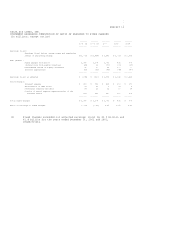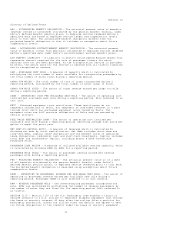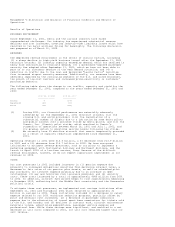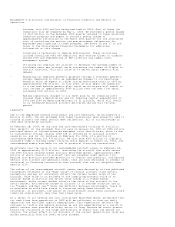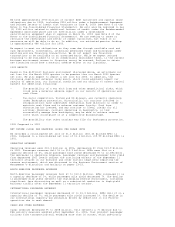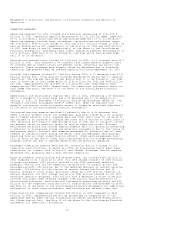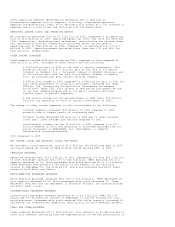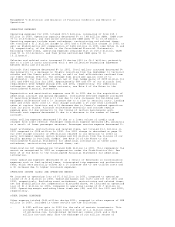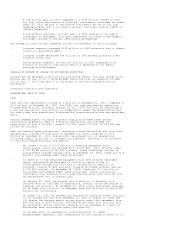Delta Airlines 2002 Annual Report Download - page 112
Download and view the complete annual report
Please find page 112 of the 2002 Delta Airlines annual report below. You can navigate through the pages in the report by either clicking on the pages listed below, or by using the keyword search tool below to find specific information within the annual report.We have approximately $700 million of current debt maturities and capital lease
obligations due in 2003, including $301 million under a Reimbursement Agreement
and related letters of credit that terminate on June 8, 2003 (see Note 6 of the
Notes to the Consolidated Financial Statements). We will also be required to pay
(1) $102 million related to additional letters of credit under the Reimbursement
Agreement mentioned above and (2) $250 million under a receivables
securitization agreement when it expires on March 31, 2003 (see Note 8 of the
Notes to the Consolidated Financial Statements). We are seeking to renew or
refinance the receivables and letter of credit facilities, but there is no
assurance we will be able to do so. In addition, our estimated pension funding
is approximately $80 million for 2003.
We expect to meet our obligations as they come due through available cash and
cash equivalents, investments, internally generated funds and borrowings under
existing and new financing transactions. We do not expect new financing
transactions to be available on an unsecured basis. While we expect secured
financing to be available to us on commercially reasonable terms, in the current
business environment access to financing cannot be assured. Failure to obtain
new financing could have a material adverse effect on our liquidity.
2003 RESULTS
Based on the difficult business environment discussed above, we anticipate our
net loss for the March 2003 quarter to be greater than our March 2002 quarter
net loss. We also expect to report a net loss for 2003. In addition, the
following significant external risks exist, which could adversely impact our
results of operations, our financial condition and our ability to access capital
markets for additional financing:
- The possibility of a war with Iraq and other geopolitical risks, which
could have a material adverse impact on our results of operations and
cash flows.
- Two major competitors, United and US Airways, are currently operating
under bankruptcy protection. Historically, air carriers involved in
reorganizations have undertaken substantial fare discounts in order to
maintain cash flows and to enhance customer loyalty. Such fare
discounting has lowered, and may continue to lower, yields for all
airlines. Moreover, carriers operating in bankruptcy, or that
successfully emerge from bankruptcy, may be able to achieve reduced
costs which could place us at a competitive disadvantage.
- The possibility that other carriers may file for bankruptcy protection.
2002 Compared to 2001
NET INCOME (LOSS) AND EARNINGS (LOSS) PER SHARE (EPS)
We recorded a consolidated net loss of $1.3 billion ($10.44 diluted EPS) in
2002, compared to a consolidated net loss of $1.2 billion ($9.99 diluted EPS) in
2001.
OPERATING REVENUES
Operating revenues were $13.3 billion in 2002, decreasing 4% from $13.9 billion
in 2001. Passenger revenues fell 5% to $12.3 billion. RPMs were flat on a
capacity decline of 4%, while passenger mile yield decreased 5% to 12.08(cents).
The decreases in operating revenues, passenger revenues and passenger mile yield
from depressed 2001 levels reflect the continuing effects of the September 11
terrorist attacks on our business and other factors negatively impacting the
revenue environment, which are discussed in the Business Environment section of
Management's Discussion and Analysis on pages 13-15.
NORTH AMERICAN PASSENGER REVENUES
North American passenger revenues fell 6% to $10.0 billion. RPMs increased 1% on
a capacity decrease of 3%, while passenger mile yield decreased 7%. The decline
in passenger mile yield reflects the challenging revenue environment, including
significant fare discounting as well as a substantial reduction in high-yield
business traffic after the September 11 terrorist attacks.
INTERNATIONAL PASSENGER REVENUES
International passenger revenues decreased 2% to $2.3 billion. RPMs fell 2% on a
capacity decline of 7%, while passenger mile yield increased 1%. The decline in
our international capacity was primarily driven by reductions in our Pacific
operations due to weak demand.
CARGO AND OTHER REVENUES
Cargo revenues decreased 9% to $458 million. This reflects a 7% decline due to
FAA security measures adopted after September 11, 2001, that prohibit passenger
airlines from transporting mail weighing more than 16 ounces, which previously





